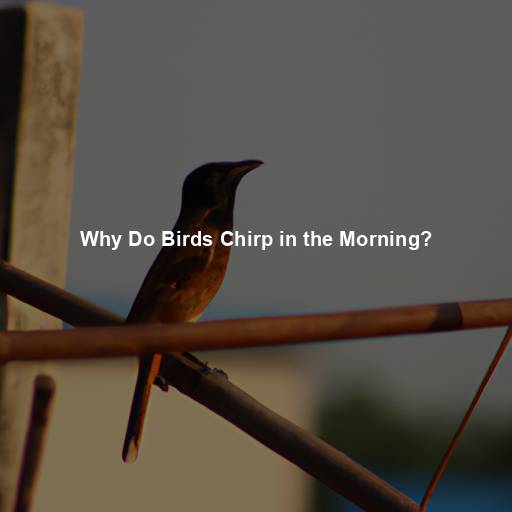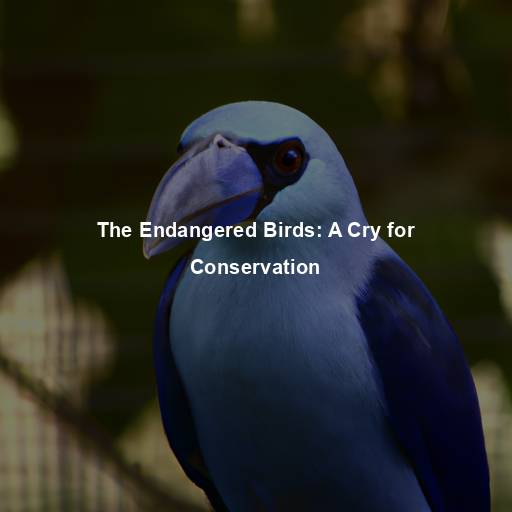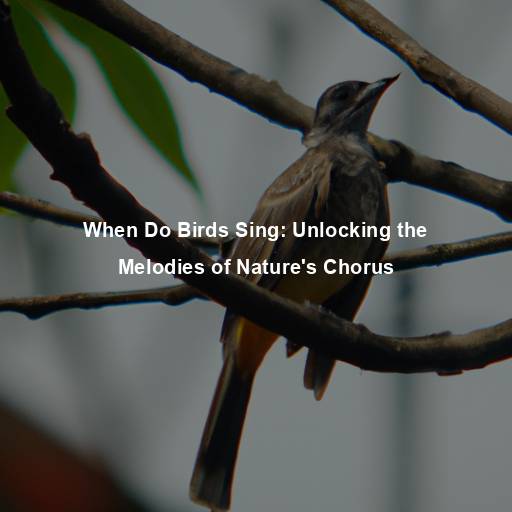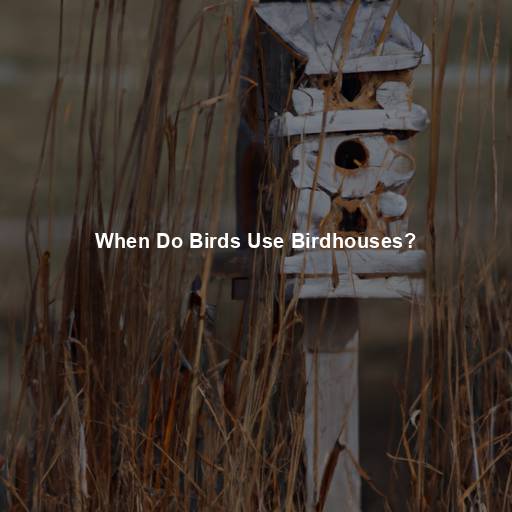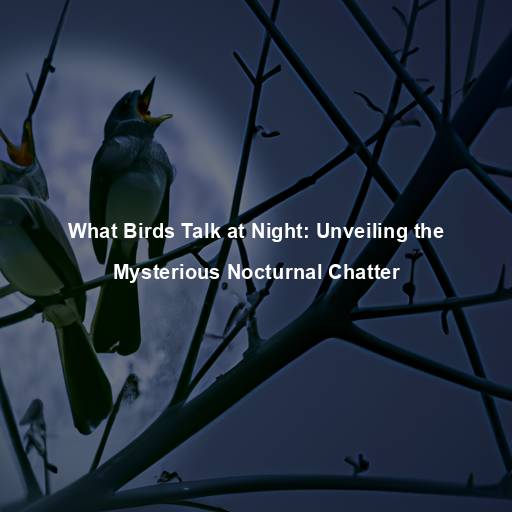What Birds Chirp at Night in Ontario: A Fascinating Exploration of Nocturnal Avian Life
Last Updated on November 4, 2023 by Evan
Contents
- 1 The Enchanting World of Nocturnal Birds
- 2 The Nocturnal Chirpers of Ontario
- 3 Preserving the Nocturnal Harmony
- 4 Embracing the Nocturnal Symphony
- 5 Unlocking the Secrets of Nocturnal Bird Behavior
- 6 The Importance of Nocturnal Bird Conservation
- 7 Immerse Yourself in the Nighttime Symphony
- 8 FAQs – What Birds Chirp at Night in Ontario?
- 8.1 What birds are known for chirping at night in Ontario?
- 8.2 Why do birds chirp at night?
- 8.3 Are there any other birds that chirp at night apart from owls?
- 8.4 How can I identify different bird calls at night in Ontario?
- 8.5 Can I attract nighttime birds to my yard?
- 8.6 Is it common to hear birds chirping at night in Ontario?
The Enchanting World of Nocturnal Birds
Birds are fascinating creatures that captivate our attention with their vibrant plumage, melodious songs, and graceful flight. While we often associate birds with daytime activities, there is a hidden realm of avian life that comes alive with the setting sun – the world of nocturnal birds. In Ontario, Canada, a variety of birds emerge from the shadows to serenade the night with their enchanting chirps and calls. In this article, we will delve into the mysterious world of nocturnal birds in Ontario and explore the species that fill the night sky with their mesmerizing melodies.
Unveiling the Nocturnal Symphony
As the sun sets and shadows stretch across the land, nature unveils its mesmerizing nocturnal ballet. In this mysterious realm, winged performers emerge from the depths of obscurity to captivate us with their enigmatic charm. While some feathered artists choose to retreat to their nests as twilight beckons, others embrace the cloak of night, embarking on an extraordinary journey of survival and illumination. The abundant landscapes of Ontario, with their wide-ranging ecosystems, serve as a sanctuary for an ensemble of nocturnal aviators, each lending their unique notes to the symphony of darkness.
The Nocturnal Chirpers of Ontario
The Eastern Whip-poor-will (Antrostomus vociferus)
Ontario, a province known for its diverse wildlife, harbors a truly mesmerizing creature – the Eastern Whip-poor-will. This remarkable bird boasts a captivating call that seems to echo its very name, adding an air of mystique to the night. With their intricate mottled brown feathers, Whip-poor-wills seamlessly blend into their natural surroundings – a true testament to Mother Nature’s artistry. As avid insectivores, they gracefully navigate the skies, seizing their prey with their impressively broad mouths.
The Barred Owl (Strix varia)
With its soulful hoots echoing through the forests of Ontario, the Barred Owl adds a touch of mystery to the night. These magnificent birds of prey are known for their iconic “Who cooks for you? Who cooks for you all”? call, which carries far into the darkness.
The Common Nighthawk (Chordeiles minor)
Prepare to be amazed by the incredible Common Nighthawk, a bird that defies convention with its extraordinary skills. In Ontario’s summer months, these airborne artists put on a mesmerizing show, showcasing their remarkable agility and lightning-fast flight. As darkness falls, the Common Nighthawks take to the skies, indulging in a feast of nocturnal insects. Their unforgettable “peent” call, reminiscent of the gentle melodies produced by blowing across the top of a bottle, fills the evening air, adding an enchanting soundtrack to the spectacle.
The Eastern Screech-Owl (Megascops asio)
Hidden among the trees of Ontario’s woodlands, the Eastern Screech-Owl is a master of disguise. These small owls are known for their remarkable camouflage, which allows them to blend seamlessly with their surroundings. Despite their name, their call is not a screech but rather a haunting trill or whinny. Eastern Screech-Owls are opportunistic hunters, preying on a variety of small creatures, including mice, insects, and even other birds.
The Chuck-will’s-widow (Antrostomus carolinensis)
Venturing south from its wintering grounds, the Chuck-will’s-widow graces Ontario with its enchanting presence during the summer months. As its name suggests, this nocturnal bird’s call resembles the sound of someone whispering, “Chuck-will’s-widow”. While similar to the Eastern Whip-poor-will in appearance, the Chuck-will’s-widow has a longer tail and a more mottled plumage pattern. These birds primarily feed on insects, which they capture in flight using their wide mouths.
Preserving the Nocturnal Harmony
While the enchanting songs of nocturnal birds in Ontario bring joy to our ears, it is vital to ensure their habitats and well-being are protected. As human activities continue to encroach upon the natural world, it is crucial to take steps to preserve the ecosystems that these birds rely on. Here are some ways we can contribute to the conservation efforts:
Protecting Natural Habitats
Our intertwined existence with nature is a delicate ballet, orchestrating the symphony of life. In this harmonious dance, nocturnal birds emerge from the shadows, enchanting us with their elusive beauty. But their survival hinges on the preservation of their habitats, urging us to rally behind initiatives that safeguard woodlands, forests, and wetlands. By nurturing these sanctuaries, we create havens where these creatures can spread their wings and embrace the mysteries of the night sky.
Reducing Light Pollution
Excessive artificial lighting can disrupt the natural rhythms and behaviors of nocturnal birds. By minimizing light pollution and using energy-efficient lighting, we can create a more welcoming environment for these birds and reduce the negative impacts on their habitats.
Promoting Responsible Pet Ownership
Domestic cats, when allowed to roam freely, can pose a threat to nocturnal birds and their nests. Encouraging responsible pet ownership, such as keeping cats indoors or providing supervised outdoor access, can help mitigate the risks to these vulnerable bird populations.
Supporting Citizen Science Projects
Participating in citizen science initiatives, like bird monitoring programs, allows us to unravel the mysterious world of nocturnal avians. By joining these projects, we not only fuel scientific research but also contribute to the art of conservation. Our collective efforts shed light on the enigmatic distribution patterns and population trends of these elusive creatures, unveiling a tapestry of knowledge that was once shrouded in darkness.
Educating Others
Spreading awareness and knowledge about the importance of nocturnal birds and their conservation is crucial. By sharing information and inspiring others to appreciate these fascinating creatures, we can collectively work towards a future where the nocturnal symphony continues to enchant generations to come.
Embracing the Nocturnal Symphony
As the sun sets and darkness envelops Ontario, a mysterious world awakens. Emanating from the depths of hidden nests and perches, a symphony of nocturnal birds fills the air with a tapestry of sounds that bewilder the senses. From the haunting hoots of the Barred Owl to the enchanting melodies of the Whip-poor-will, each species adds its unique thread to this mesmerizing nocturnal symphony. By immersing ourselves in the wonders of these remarkable creatures, we forge a profound connection with the natural realm and become stewards of their conservation.
The Great Horned Owl (Bubo virginianus)
The mystical creature known as the Great Horned Owl holds an undisputed reign over the enigmatic realm of the Ontario night. With eyes like golden orbs, and tufted ears that stand out in bold defiance, these majestic avian predators command attention and curiosity. It is their haunting call, a melodic cascade of “hoo-hoo-hoo-hoo,” that echoes through the ancient woods, captivating those fortunate enough to bear witness. A master of adaptation, the Great Horned Owl navigates diverse landscapes with ease, effortlessly traversing between dense forests and expansive fields in pursuit of its prey – a formidable arsenal of rodents, rabbits, and even fellow feathered creatures.
The Northern Saw-whet Owl (Aegolius acadicus)
In the mystical realm of the moonlit forests, a creature of both intrigue and allure reigns supreme – the Northern Saw-whet Owl. Its petite physique belies a vocal prowess that, when unleashed in the night, resonates with the astonishing might of a sharpening saw on a whetstone. This enigmatic species, aptly named after its distinctive call, thrives amidst the dense tapestry of coniferous forests and wooded retreats that adorn the landscape of Ontario. With their artful disguise of plumage and diminutive stature, these avian masters of stealth expertly navigate the shadows, embarking on silent hunts to satiate their appetite for mice and small birds.
The American Woodcock (Scolopax minor)
While most birds find solace in their nests during the night, the American Woodcock takes to the skies to perform its mesmerizing aerial courtship display. As dusk settles, males can be observed spiraling upward before descending in a series of zig-zags, producing a distinctive “peent” call as they go. This unique display is a sight to behold and is often accompanied by a symphony of chirping and trilling sounds. The American Woodcock’s habitat of choice includes moist woodlands and fields, where they probe the soil for earthworms and insects with their long bills.
The Whip-poor-will (Antrostomus vociferus)
There is a fascinating creature that roams the night in Ontario, resembling the well-known Eastern Whip-poor-will. This mysterious bird, known as the Whip-poor-will, possesses a mottled brown plumage that effortlessly blends into the surrounding woodland, shrouding it in a veil of enigma during daylight hours. As the sun begins to fade and darkness settles, these elusive beings awaken, their presence most vibrant at the cusp of dawn and dusk. It is during these bewitching times that their unforgettable “whip-poor-will” call reverberates through the atmosphere, leaving a sense of awe and wonder in its wake.
Unlocking the Secrets of Nocturnal Bird Behavior
Nocturnal Adaptations
As twilight descends, the mysterious realm of the nocturnal birds unfurls before us, filled with enigmatic adaptations. These masterful creatures have honed their senses to conquer the darkness, unveiling a captivating symphony of survival strategies. Their eyes, like celestial windows, harbor secrets of evolution, with specialized retinas, an army of rod cells, and the magical presence of light-sensitive oil droplets. And as their large orbs pierce the night, a world once shrouded in obscurity is illuminated, revealing the stealthy predators and wary prey that navigate this perplexing domain.
Navigating the night sky poses a unique challenge for nocturnal birds. Many rely on a combination of celestial cues, such as the positions of stars and the moon, to navigate during their nocturnal flights. Some species, like the Barred Owl, have asymmetrical ear openings that allow them to pinpoint sounds accurately, helping them locate prey even in complete darkness.
Communication and Mating Rituals
For many nocturnal bird species, the cover of night offers a prime opportunity for communication and courtship. Males often use their calls to establish territories, attract mates, and engage in elaborate courtship rituals. These vocalizations serve as a means of communication, allowing individuals to recognize each other, convey information, and defend their territories.
Hunting Strategies
The nocturnal realm has birthed countless enigmas when it comes to our feathered friends, particularly those adorned with captivating night gowns. Take the illustrious Great Horned Owl, whose impeccable hearing serves as the ultimate sonic compass, guiding them with bewildering prowess through the dimly lit undergrowth where their targets anxiously stir. While some avian hunters, like the American Woodcock, gracefully deploy their elongated bills to discreetly probe the earth’s surface, unearthing worms and insects hidden beneath. Oftentimes, it is the enigmatic silence of owls’ flight that leaves us gawking in awe, as they seamlessly descend upon unsuspecting prey, their audio stealth unparalleled.
The Importance of Nocturnal Bird Conservation
The enchanting world of Ontario’s nocturnal avian community holds secret powers that are intricately woven into the very fabric of the ecosystem. As dusk paints the horizon with its mysterious hues, these avian heroes emerge, poised to fulfill their purpose. Their nocturnal prowess in managing insect and small mammal populations is the tangible manifestation of a delicate balance, tirelessly maintained for the preservation of biodiversity and ecological harmony. Yet, their existence hangs in the balance, imperiled by the menacing forces of habitat loss, light pollution, and the indiscriminate menace of pesticides.
Immerse Yourself in the Nighttime Symphony
As dusk settles over Ontario, a bewitching serenade ensues, courtesy of the mysterious nocturnal birds. From the eerie echoes of the Barred Owl’s haunting hoots to the captivating melodies of the Eastern Screech-Owl’s trills, each feathered maestro contributes a unique note to the enigmatic nocturnal symphony. As you find yourself enveloped in the darkness, pause for a moment to marvel at the marvels of the nocturnal realm. Tune into the melodious chirps, bear witness to the graceful dances through the air, and ponder the remarkable adaptations that enable these avian creatures to flourish in the obscurity.
FAQs – What Birds Chirp at Night in Ontario?
What birds are known for chirping at night in Ontario?
In Ontario, some of the birds that are known for chirping at night include the Eastern Screech-Owl, the Great Horned Owl, and the Whip-poor-will. These birds are nocturnal species and are more active during the night, using their distinctive calls to communicate and establish territories.
Why do birds chirp at night?
Birds chirp at night for various reasons. One primary reason is to attract mates and communicate with other individuals of the same species. These calls serve as territorial markers and help establish the boundaries of their nesting or feeding areas. Additionally, some bird species may also vocalize at night to defend their territory or to warn off potential threats.
Are there any other birds that chirp at night apart from owls?
When darkness befalls Ontario, it’s not just the wise owls who awaken the night with their enigmatic hoots. The mystifying avian world also holds a surprise in the form of the American Woodcock, whose courtship displays are accentuated by a mesmerizing “peent” call. As the sun bids its farewell, the Common Nighthawk emerges, its haunting “pik-a” or “beer-ack” resounding through the skies, as it embarks on a captivating insect-hunting expedition. These exquisite species have gracefully adapted to embrace the twilight hours, leaving us in a state of perpetual enchantment.
How can I identify different bird calls at night in Ontario?
When it comes to deciphering the enigmatic soundscapes of the nocturnal avian realm, one cannot deny the perplexing puzzle that lies before us. Every chirp, every caw, holds within it a tantalizing tapestry of complexity. Take the majestic owl, for instance, whose melodious symphony of hoots and calls dances through the moonlit air. From the deep hoots of the Great Horned Owl to the ethereal trills of the Eastern Screech-Owl, each species unveils a distinct sonic signature. And let us not forget the enigmatic Whip-poor-will, whose mysterious repetition of its own name leaves us pondering its subtle secrets of the night.
Can I attract nighttime birds to my yard?
If you’ve ever wished to transform your yard into a captivating haven for nighttime birds, we’ve got some mind-boggling tips for you. Picture this: installing bird feeders that serve up a feast of insects or petite rodents, enticing those feathered creatures with an all-you-can-eat buffet. And wait until you hear about the luxurious amenities we’ll be suggesting, like cozy nesting boxes and fashionable roosting spots nestled amongst your favorite trees and shrubs. But that’s not all, folks — reducing artificial lighting and curbing noise pollution will seal the deal, creating an irresistibly exclusive ambiance for these enigmatic creatures of the dark. Are you ready to enter a world of avian enchantment?
Is it common to hear birds chirping at night in Ontario?
Ah, the nocturnal symphony of Ontario’s avian inhabitants! From dusk till dawn, their mysterious melodies permeate the air, creating an enchanting ambiance that never fails to captivate. Each region, with its own clandestine cast of characters, unveils a unique avian ensemble, shrouded in a veil of secrecy. Certainty becomes elusive, as the ever-changing seasons and dynamic habitats dictate the intricate choreography of these nighttime performers. Amidst urbanization and unforeseen environmental shifts, the ebb and flow of their presence becomes a fascinating enigma, stimulating our curiosity and leaving us with a sense of wonder at nature’s boundless perplexity.



